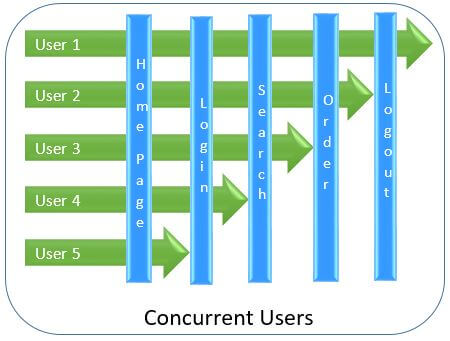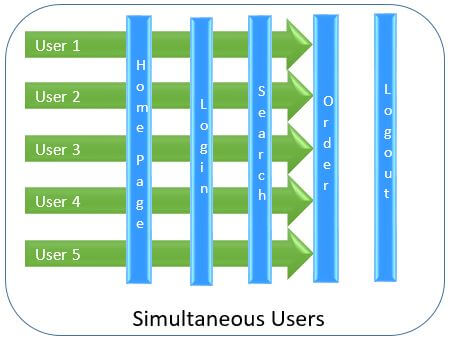There are many different definitions available on Google for simultaneous and concurrent users. Some definitions state that simultaneous users are active users and perform different activities while some definitions point out that concurrent users are those users who do the same activities.
To understand the difference, I would suggest to understand the meaning of these two words. If you know the exact meaning of simultaneous and concurrent words then you can easily correlate them with performance testing terms.
Concurrent Users:
The word concurrent is used only for the events that occur over a period of time i.e. for a span of time. In the performance testing term, you would say ‘a period of time’ implies ‘test duration’.
Hence the users who are running under a test plan; irrespective of the activities they are doing; are ‘Concurrent Users’.

Simultaneous Users:
The word simultaneous is used for the events that occur at a point in time. In the performance testing when you instruct all the users to perform the same transaction together then at that particular point those users become ‘Simultaneous Users’.
The feature of Micro Focus LoadRunner Rendezvous Point helps us to make Vuser simultaneous by holding the Vuser at a particular transaction and releasing them all together.

In the LoadRunner tutorial, there is one practice scenario which states:
- The application must successfully handle 10 concurrent travel agents.
- The application must be able to process 10 simultaneous flight bookings with a response time not exceeding 90 seconds.
Point 1 implies that the application must be able to handle 10 travel agent loads (over a period of time) irrespective of their activities. Hence they used the term ‘concurrent’.
Point 2 implies that the application must be able to handle 10 simultaneous bookings (at a point in time). That means all the travel agents must click the ‘Book the Flight’ button at the same time. You can simulate this scenario via a rendezvous point.
Some important points:
- Both the words mean “occurring at the same time”, but “concurrent” represents the events that occur over a period of time whereas “simultaneous” represents the events that occur at a point in time.
- The simultaneous user is a subset of the concurrent user.
- Simultaneous users can be concurrent users, but concurrent users cannot be simultaneous users.
- Generally, the number of concurrent users on an application is more than the number of simultaneous users.
- All the simultaneous users must be active and perform the same activities at a point in time.
- Concurrent users may be active or inactive and may perform different activities.

